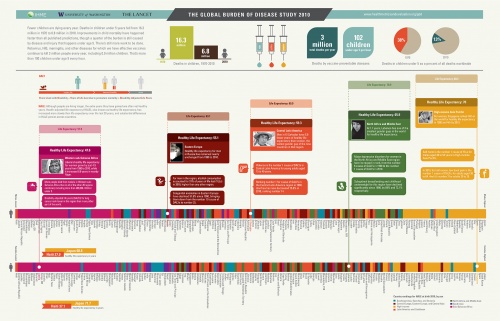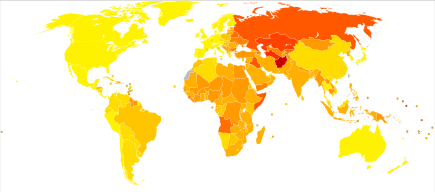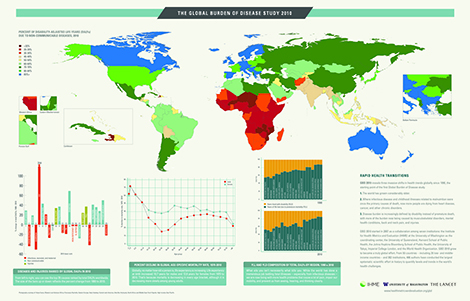Measuring Global Health
Original Editor - Wendy Walker
Top Contributors - Wendy Walker, Rachael Lowe, Naomi O'Reilly, Kim Jackson, Admin, Jess Bell, Laura Ritchie, Tarina van der Stockt and Franca Ebomah
Introduction[edit | edit source]
Measuring global health is frequently defined in terms of measurement of the Global Disease Burden [GBD] which is defined as the impact of a health problem as measure by mortality, morbidity and financial cost.
Various diseases put a different amount of disease-burden on a population and has become the most common method in order to compare across nations. When comparing GBD data from different countries, there is a marked difference between nations which are developed to a greater or lesser degree.
Global Burden of Disease (GBD) Project[edit | edit source]
The Global Burden of Diseases, Injuries, and Risk Factors Study (GBD) is the single largest and most detailed scientific effort ever conducted to quantify levels and trends in health. The study reported the health effects of more than 100 diseases and injuries in 8 regions of the world in the year 1990. Led by the Institute for Health Metrics and Evaluation (IHME) at the University of Washington, it is truly a global effort, with over 1,000 researchers from more than 100 countries, including 26 low- and middle-income countries, participating in the most recent update. The GBD provides a tool to quantify health loss from hundreds of diseases, injuries, and risk factors, so that health systems can be improved and disparities can be eliminated.
It produced estimates of mortality and morbidity by age, sex and region.
The ongoing Global Burden of Disease Study[1] is described as "The most comprehensive worldwide observational epidemiological study to date." It describes mortality and morbidity from disease and injury. It quantifies global, regional and national life expectancy, all-cause mortality and cause specific mortality for 249 causes of death, 1980-2015. It is led by the Institute for Health Metrics and Evaluation (HME), University of Washington, USA, and researchers are based throughout the world: there are more than 1,000 researchers from more than 100 countries, which includes 26 low and middle-income countries.
As well as examining 249 causes of death, it reviews 315 disease and injuries and 79 risk factors. The data is taken from 195 countries and territories between 1990 and 2015.
- Review the GBD data
- Download country profiles that summarise the major GBD findings related to your country

|
|
| Institute for Health Metrics & Evaluation. GBD 2010 Poster. | http://www.healthdata.org/infographic/gbd-2010-poster |
Units of Measurement[edit | edit source]
According to Murray et al[2] quantifying the burden of disease provides a means to identify conditions and risk factors that may be relatively neglected and others for which progress is not what was expected and may be used to initiate health policy dialogues.
There are a number of measurements which can be used to measure global health.
The 3 main units of measurement are the "ALYs":
- The DALY (Disability-Adjusted Life Year) is frequently used as a measure of disease burden. The World Health Organisation (WHO) use DALY measurements to compare the overall health and life expectancy of various countries.
- The QALY (Quality-Adjusted Life Year) is a measure of disease burden which accounts for both the health-related quality of life a person is predicted to experience, and the length of life expectancy.
- The HALY (Health-Adjusted Life Year) includes DALYs and QALYs in order to describe morbidity and mortality rates with a single number and are often used to estimate the burden of disease and compare the impact of specific diseases/health conditions on communities.
Daniela Sarabia provides a simple guide to understanding the current units of measurement and key terminology used when describing Global Health.
Summary[edit | edit source]
Resources[edit | edit source]
A summary of the most recent GBD Study Findings, 2015 in The Lancet.
The IHME (Institute for Health Metrics and Evaluation) website provides articles and data on world health metrics. It has an impressive interactive tool which can be used to analyse data about world health levels and trends, comparing causes and risks within a country, or comparing countries, or demonstrate how disease patterns have changed over time.
The World Health Organization website has a page on GBD and one on Global Health Observatory Data showing access to health services globally in each of WHO's 194 member states, as well as information about eqity of access.
Recent Related Research (from Pubmed)[edit | edit source]
Failed to load RSS feed from https://eutils.ncbi.nlm.nih.gov/entrez/eutils/erss.cgi?rss_guid=1TOjW_LBRK90qysMne327F2TVpL1jDL5ephuJvrjNNPdXHOg7R|charset=UTF-8|short|max=10: There was a problem during the HTTP request: 422 Unprocessable Entity
References[edit | edit source]
- ↑ GBD 201 Mortality and Causes of Death Collaborators. The Lancet, 8 Oct 2016, Vol 388, No 10053, p1459-1544
- ↑ Murray CJ, Lopez AD. Measuring the Global Burden of Disease. New England Journal of Medicine. 2013 Aug 1;369(5):448-57








